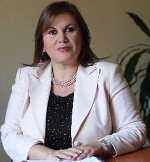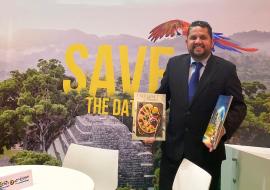Q & A with Maruja Acevedo, Deputy Director of the Guatemalan Tourism Institute

During one of the sessions of WTM 2014 in London, we sat down with Maruja Acevedo, deputy-director of the Guatemalan Tourism Institute, who told us about the potential of her country as the heart of the Mayan World, with jaw-dropping natural diversity worth feasting eyes on.
Let’s talk about the increasing number of tourists you have received this year, especially European visitors since you have already strengthened the American market.
We’re very happy. We feel like the tourism flow to Guatemala is growing and we’re now focused on the British market, which has a constant growth, and that’s the reason why we’ve sat down with tour operators that are fostering Guatemala in this market. There’s been a continuous growth for Central America and specifically Guatemala over the past years. We’re quite interested in boosting our presence in the European market, and our main targets are Germany, Spain, Italy and France. We also have Holland and Russia among the growing markets. So, we’re intensively working with the private sector in an effort to keep on promoting Guatemala in the European market.
Are you looking for new airlift alternatives?
That’s extremely important, because if the airlift is not improved we’ll still have limited seat availability. Nowadays, the airlift flows through the United States with all the airlines that fly to Europe and Guatemala, as well as Iberia’s flight, but we’re exploring other alternatives to have airlift enhanced and the tourists flow increased.
Do you believe Iberia is going to add more flights?
We have scheduled a meeting with them and we’re looking forward to having positive results, since we’ve been told that they sell all their seats in every flight, which entails higher prices as a result of the high demand, so we strongly believe that there is a possibility to have the number of flights increased, as well as other alternatives such as Cancun. I think that we’ll have new developments for the next summer season.
In terms of market promotion, Europa is important, as well as America. But are you also aiming at South America and interregional tourism in Central America?
Yes, definitively. Our joint effort as a multi-destination that targets Europe is to be strengthened and consolidated, but at regional level we are nearly 50 million Central Americans, most of which don’t know our very own region, so packages and tourism programs are being promoted for Central American people to travel within the region, and we’re also looking at other outstanding South American economies such as Brazil, Argentina, Chile and Colombia.
So we want to strengthen our position in Europe and foster a multi-destination strategy in South America. The airlift into the region has been improved, we have Avianca and Copa, and that helps us work with the region and channel that tourism to Central America.
What are you going to promote this year in Guatemala? Do you have any centralized package, any new project in the offing?
We’ve been fostering the specialized tourism; we have special adventure, ecotourism and culture programs. In this market, for instance, in Germany, Guatemala promotes Spanish-teaching schools: there are nearly a hundred of Spanish-teaching programs and agreements with international universities. That’s an interesting matter, sometimes related to the voluntary service that can be provided in Guatemala with positive social impact. We’re working this line, but we always position Guatemala as the Heart of the Mayan World, with all the natural diversity we have.
Is that what actually makes Guatemala be a choice other than what the neighboring countries have to offer?
We have one of the main archaeological sites of the Mayan civilization, but the Mayan culture is all over us: over 50 percent of our people are Mayan descendants. We also have the influence of contemporary and colonial cultures. It’s a cultural blend and we think that Europeans are very interested in these elements, as well as the natural beauty of volcanoes, lakes, rivers. They perfectly complement the offer of territorially small countries, so visitors can easily go from one place to another and enjoy the multi-destination.
You’re taking the first steps with your “Guatemágica” project and that can be a great development, can’t it?
Yes, this region definitively has great potential, the IRTRA theme parks have been developed there with water attractions, new nature parks are being built, and it has become a tourism circuit that already receives over a million visitors. Takalik Abaj, a Mayan archaeological site, is also nestled in this region. It also features places to enjoy ecotourism, mangrove swamps, there’s great diversity in this region and it’s a tourism circuit that attracts Central American market and the south of Mexico, since it’s very easy for people that live in the border with Mexico to go to Guatemala, even easier than going to the D.F.
We’re witnessing an important tourism movement that opens doors to create new products like agro-tourism, combined with visits to the Guatemalan altiplano, the Quetzaltenango region or Atiplán Lake. So we’re betting on this region because we strongly believe that it can become a high-level tourism circuit in Central America, with over a thousand rooms. We’re looking forward to seeing it grow.
Tikal is Guatemala’s tourism core with impressive historic importance. Can it be labeled as regional multi-destination starting with Tikal? Can you travel to Guatemala, go to Tikal the following day and combine the trip with Honduras’ beaches?
Definitively, or you can do it with Cancun. We believe in regional multi-destination and participate in several regional projects. In Central America each country has complementary tourism products and we can be a very attractive region, since it’s small and it’s very feasible for people that come from long-haul markets to move throughout Central America because of the size of the region, as well as the airlift. We participate in another regional project, Mayan World, which includes the five South-Mexican states that feature Mayan culture, as well as Belize, Salvador, Honduras and Guatemala, and we have projects to foster this Mayan Route as we believe that people are very interested in getting to know it, an incredibly rich route that combines elements from every country.
We’re also working on another project, named Mayan Beach, in collaboration with the Dominican Republic to connect the European tourism with the beaches of that country and the Mayan civilization in Guatemala, a perfect merge of Mayan culture and beach, since we know that European tourists love ending their visits in the beach.
Is cruise travel a main sector for Guatemala to invest in?
It’s an important tourism sector. Guatemala is bathed by two oceans: Pacific and Atlantic. We have cruise terminals in both of them. We received 75 cruises this year and think it’s very positive because the tourists come to the country and see what Guatemala has to offer, so we can get more tourists visiting us. We take it as a Mega Fam, where people visit the country, feel our culture, out nature and realize that there is a lot to see, so they need to come back for more. That’s how we see it, and there is also a positive impact as cruise tourists spend an average of $ 100 a day in the country, and this flow our foreign currency into the economy contributes to the creation of jobs and improvement of the life quality of people working in the sector.














